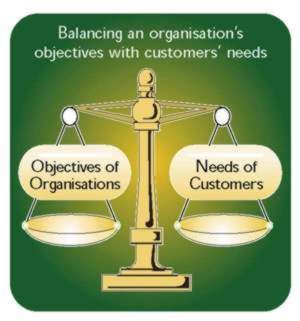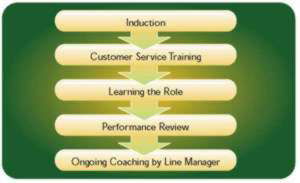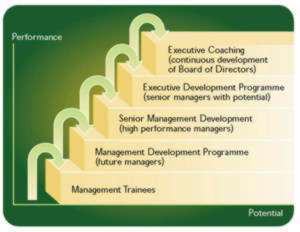In the modern business world, organisations must deal with rapid change. These include new technologies, e-business, and new and different types of competition. Organisations also have to handle customers’ requirements. In many industries these are becoming increasingly sophisticated. To flourish in this changing world, intelligent organisations monitor their changing business environment. They also recognise the need to invest in their workforce, so that employees are able to adapt and respond to changing requirements.

Business organisations need customers. Customers look for good customer service. It’s not enough, for example, to be known as a supplier. A business must supply all that is asked for, courteously, on time, in the right quantities, and in prime condition. Customer service, however, is not something that simply happens. It is a complex process. It involves developing and managing customer relationships before, during and after a transaction. Good service will do more than meet customer needs. It will also provide the organisation with a distinct competitive advantage in the market place.
This Case Study illustrates how an organisation can put customer service at the centre of its staff development programme to establish a culture that provides a foundation for growth. It shows how Travis Perkins has managed to balance its own strategic objectives with its customers’ needs for good service.

Travis Perkins
The business name ‘Travis Perkins’ is relatively new, but the company has evolved within the building trade over a long period. It was in 1988 that Travis & Arnold and Sandell Perkins, two building merchant public companies, merged to create Travis Perkins. Ernest Travis founded Travis & Arnold in London in 1899. The business eventually moved to Northampton. It sold timber and other wood products before diversifying into other building materials. Sandell Perkins had origins stretching back to 1797. The business originally traded as joiners and carpenters and then moved into selling and trading in hardwoods. It became a public company in 1986.
Today the Travis Perkins Group is one of the UK’s largest distributors of building materials. Its business objective is to provide a high level of service that exceeds customer expectations. At the same time, it looks to use customer service to build a strong basis for growth. Travis Perkins trades under a number of brand identities, recognising the importance that customers place on an established reputation and identity within the overall market place.
Travis Perkins – trading in general Building Materials, Timber, Forest Products, Toolhire.
Keyline – greater focus on Heavy Building Materials and Civil Engineering
City Plumbing – proven brand within the plumbing and heating market
CCF – specialising in insulation products, partitioning, ceilings.
Growth
Not all organisations benefit from being big, but many certainly do. All organisations will aim for the size of business that suits them best.

Every organisation needs to decide just how big it needs to be to best meet the needs and expectations of its major stakeholders. It knows that, as organisations become larger, they often benefit from economies of scale that reduce unit costs and increase profitability.
For each business, there will be a level of operation at which unit costs of production are at their lowest possible level. Reaching this point provides the organisation with the opportunity to maximise its profitability. Being profitable is the surest way of managing to stay in business. Growing bigger may offer the best long term hope of profitability.
Economies of scale include internal economies and external economies. Internal economies are gains made within the organisation as a result of becoming bigger. These include benefiting from large discounts through buying in bulk or being able to afford to use techniques and equipment unavailable to smaller firms. External economies are gains that come from outside the organisation. These may include easy access to a skilled labour force, the bonus of a high reputation for the industry in that area, specialist trade associations and being close to specialist suppliers.
Travis Perkins’ business strategy is built around growth. Having merged horizontally in 1988 the company now has a 16% market share of building materials distribution. It intends to increase this to 20% through further acquisitions. The Group’s strong record of growth has created economies of scale.
These economies have provided Travis Perkins with an operating margin of 12%; this figure is unusually high for this industry. The economies have contributed to the company’s increased profitability. This has produced a strong cash flow. The healthy cash flow is reassuring to all stakeholders, investors, staff and the financial institutions from whom Travis Perkins is looking to borrow funds to finance its growth.
As part of its growth strategy, Travis Perkins aims to increase its number of branches from 740 to over 1,200 during the next six years. It aims to do this by buying up small independent merchants in towns of at least 8,000 people that are not less than 5 miles from another Travis Perkins branch. It then intends to re-brand these businesses and integrate them into its company network.
Business culture

Every business organisation has a particular way of looking to achieve its business objectives. It also has its own ways of working. Culture refers to an organisation’s key characteristics. It includes the shared beliefs and the written and unwritten policies and procedures that determine the ways in which the organisation and its people behave in order to solve business problems and meet business objectives.
It is possible to gain a feel for the culture of an organisation by looking around and talking to people who work for it. At the heart of Travis Perkins’ culture is the assertion that quality of service is paramount. The company has good reason to take this view. Firms in the building industry work to tight deadlines. Jobs have to be finished on time. Any hold-ups due to supply delays are costly and annoying. They can be expensive; many contracts contain penalty clauses relating to delayed completion. A good reputation that takes years to establish can easily be damaged if you let your customers down.
Firms that buy materials from Travis Perkins want to pick up the right materials quickly so that they can proceed with their work. The Travis Perkins vision is to “deliver a professional, high quality service that keeps us ahead of our competitors in our customers’ eyes”. To achieve this vision and to turn this commitment towards customer service into practical actions, Travis Perkins has invested heavily in a process of training, development and performance monitoring.
Training and development
In the UK, the provision of services accounts for the majority of employment opportunities. That being so, intelligent organisations recognise that their strength lies in the skills of their work force and how good they are at meeting customers’ needs.
Travis Perkins places a high priority on continuously improving its workforce through training and development. In this way, it has developed a business culture that remains competitive so that service and growth will develop alongside each other.
The company’s focus on training its staff to offer first class customer service is evident in its programme for new recruits. Having first been inducted, new employees go through customer service training, and also learn about their role within the organisation. Their performance is continuously reviewed and they receive ongoing coaching from their line manager. At the same time new employees receive skills training across a range of areas such as:
- team and personal effectiveness
- information and communication skills
- customer care
- keeping proper accounts.

In 2003 Travis Perkins launched Excel. This is a customer service programme, aimed at continuously improving services to customers. It links training processes to the need to provide high quality customer care. It constantly poses the question, ‘What do your customers want from you?’ It makes clear how the firm’s interests are best served by meeting customers’ needs.
The programme covers all employees: yard workers, counter assistants, management trainees, branch managers, senior executives. The company has developed a wealth of learning materials.
It has also set up a Development Zone. Here, employees can book a session during working hours and complete a variety of courses at their own pace. The company encourages employees to take part in a number of programmes, both ‘in house’ and also externally provided. Within each programme, managers, trainers, supervisors, other employees and each participant assess themselves against their own training and development objectives.
Management training and development
Management training and development takes place at a number of different levels. It includes:
- 2-year programmes designed for management trainees
- programmes for middle managers.
Travis Perkins has developed these courses itself. In addition, outside agencies offer programmes for senior and executive managers.

Management training programmes focus upon providing participants with the opportunity, space and freedom to explore issues of concern. Programmes vary according to need. For example, the training programme for future branch managers takes place over five months. During this time, delegates go through a range of modules that include personal development, self organisation and recruitment and selection. Each manager also produces and presents a case study.
High performance managers go through a modular programme of training where they develop a tool kit for performance known as 4i. These are:
- IMPLEMENT (Getting the key aspects right, consistently)
- INSIGHT (Building self awareness and personal effectiveness)
- INSPIRE (Getting people involved. Taking the team with you)
- IMPACT (Achieving results. Having the commercial edge).
For high performing managers this programme helps them to:
- analyse their own approach to management
- defined and manage their priorities
- better delegation and empowerment of their people
- recognise what is involved in contributing to a high-performing team that focuses on Travis Perkins’ objectives.
Conclusion

It was not so long ago that the UK Government published ‘Our Competitive Future: Building the Knowledge Driven Economy’. This became known as the Competitiveness White Paper. It emphasised that, in a modern and changing world, employees are an organisation’s most valuable assets. It is they who help to develop ‘a culture in the workplace that allows knowledge, creativity and commitment of the workforce to be fully exploited’.
For Travis Perkins, it is not enough to be highly visible and geographically close to customers. That alone will not attract sufficient trade. The company recognises that it is its employees and their understanding of how to help customers to solve problems and deal with issues that makes the organisation distinct. It also knows that this approach provides a base of care that is vital for the company’s ongoing growth and competitiveness.
